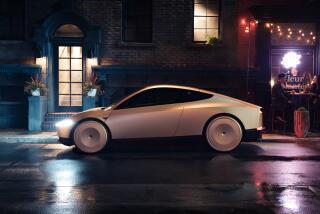Tesla plans to raise almost $2 billion to build battery factory
- Share via
Tesla Motors Inc. wants to raise almost $2 billion to help fund a giant battery factory in the Southwestern U.S. to supply its electric vehicles.
The Palo Alto automaker said Wednesday that it plans to build a “gigafactory” that would slash the cost of the battery packs for its cars, allowing Tesla to introduce a less expensive vehicle.
“Tesla is riding on its success to tell a bigger story than just being a car company,” said Thilo Koslowski, an analyst at Gartner Inc. “The batteries will attract a whole new group of investors.”
The automaker said it plans to float a debt offering that could raise up to $1.84 billion. Tesla will use the money to help finance the factory and development of a more affordable electric car that it hopes to release in about three years. Tesla hopes to sell the car for about half the price of its Model S sedan, which starts at about $70,000 and can cost more than $100,000 with options.
Tesla shares have soared this year, rising almost 82% from a low on Jan. 13 to close at a record $253 on Wednesday. The price rose an additional 3% in late trading following Tesla’s announcement of its battery plans after the market closed.
Investors will line up to buy the company’s debt, said Craig Irwin, an analyst at Wedbush Securities.
“It is the most exciting thing to happen in the auto industry since Ford went public in the 1950s,” he said.
Investors are looking at Tesla as much as a technology company as a carmaker, which explains its $31-billion stock value even though it sold fewer than 23,000 cars last year, Irwin said.
Still, Tesla is having success in cars. It is ramping up production of its Model S to about 1,000 a week. The car was named the best vehicle of the 2014 model year by Consumer Reports this week.
Tesla is thinking big in its factory plans, laying out a design that would churn out more lithium-ion batteries in a single plant than the entire industry produces now.
“This is a monster, which is why they are calling it the gigafactory,” Irwin said.
It would employ as many as 6,500 workers and would be built on 500 to 1,000 acres in Nevada, Arizona, New Mexico or Texas. Tesla said the exact site is still to be determined.
The factory will open in 2017 and ramp up to supplying batteries for the production of as many as 500,000 electric cars annually by 2020.
Tesla said the total investment will be $4 billion to $5 billion, with about $2 billion coming from the automaker and the rest coming from its partner Panasonic and other companies that might join the venture.
“We’re planning to build a large-scale factory that will allow us to achieve economies of scale and minimize costs through innovative manufacturing,” Tesla said in a statement.
The impetus for the investment is Tesla’s plan to introduce a lower-cost, mass-market electric vehicle in about three years. This so-called Gen III car would be smaller than the current Model S sedan and the planned Model X sport utility vehicle.
Tesla Chief Executive Elon Musk has said the Gen III could cost around $35,000 to $50,000 and sell by the hundreds of thousands if it achieves wide market acceptance. Lowering the cost of the batteries that go into the car is a key factor in slashing the price.
Tesla spends about $22,000 on the 85 kilowatt-hour battery pack in the Model S, Irwin said. The proposed factory could slash that about 30%, Tesla said.
Lowering the cost of battery production presents other business opportunities for Tesla, said Adam Jonas, an analyst with Morgan Stanley.
“If Tesla can become the world’s low-cost producer in energy storage, we see significant optionality for Tesla to disrupt adjacent industries,” Jonas said.
For example, Tesla could re-purpose aging battery packs from its cars into electrical storage. As the batteries age, their charge capacity declines, but even when they can’t hold enough power to operate a car for long distances, they can still have potent storage capability.
Some analysts have suggested that partially spent car batteries can be paired with rooftop residential solar systems to provide power for homeowners. But others are skeptical that would be a successful business model any time soon.
“It seems super aggressive to assume that everyone will be buying batteries for their house and putting solar on their roofs,” Irwin said.
Twitter/@latimesjerry







